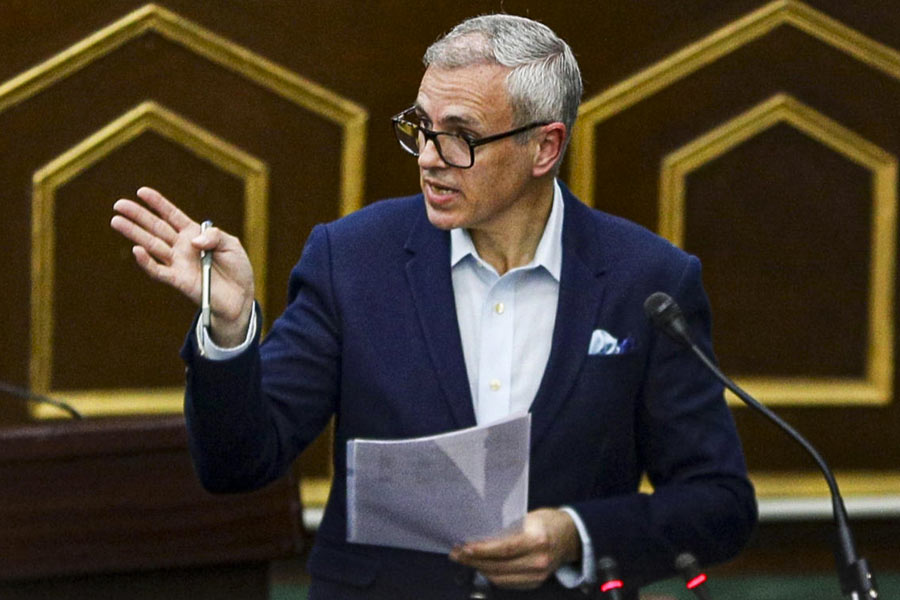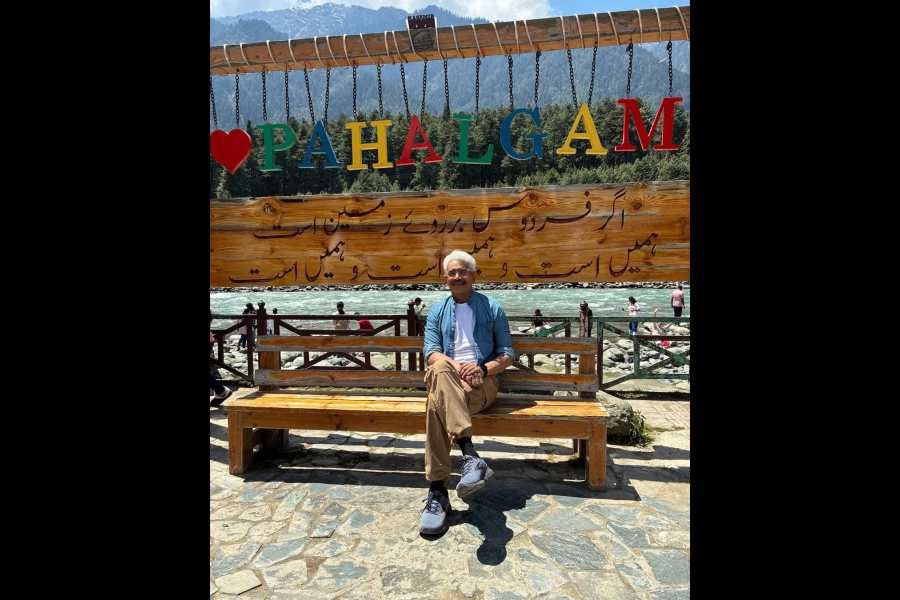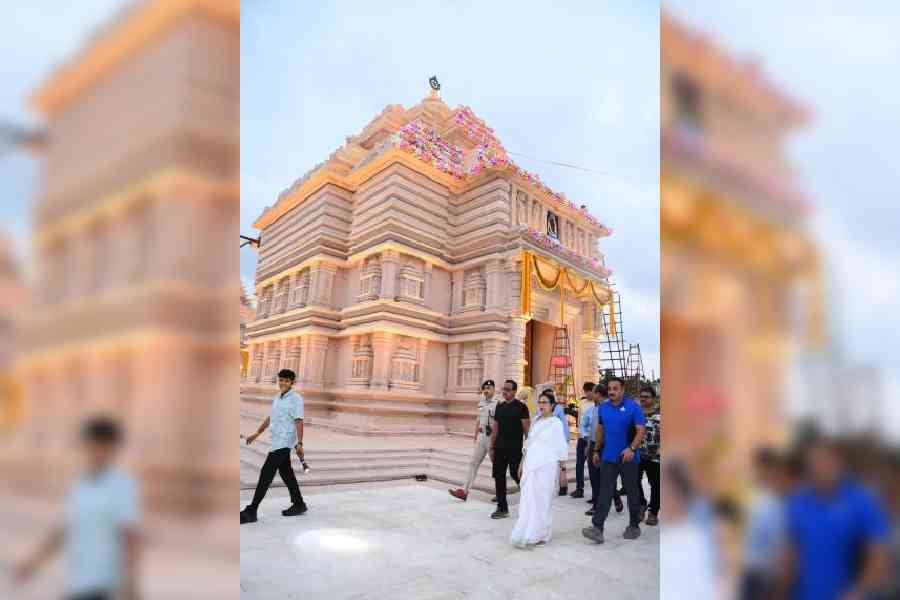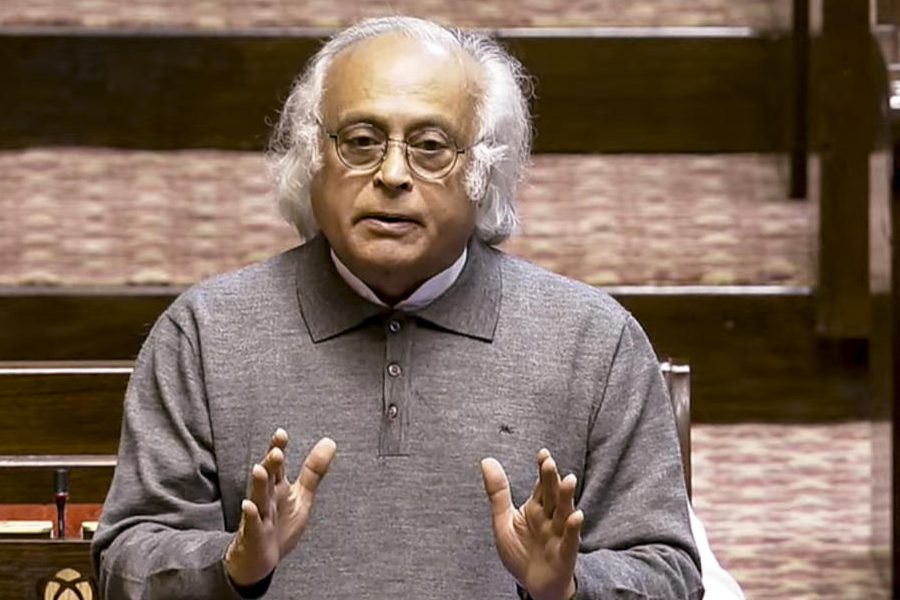 |
| (Clockwise from above) Posters of artworks by Jamini Roy, Arun Bose, Manjit Bawa and Subodh Gupta from CIMA; Coffee mugs with imprints of works by Jamini Roy and Subodh Gupta; Nandalal Bose and Amrita Shergill posters from NGMA; Cimmaron Singh has designed a neat box with a Superman motif for RAI |
Fancy your dinner plate placed on an Atul Dodiya coaster? Or how about clicking your way into cyberspace with a mouse placed on a mouse pad decorated with an artwork by Rameshwar Broota? And if you happen to be a true blue art connoisseur, perhaps you’d prefer to take a dainty sip from a Nandalal Bose coffee mug?
 |
| A reproduced poster of a work by Riyas Komu.Pic by Anindya Shankar Ray. |
Merchandising is the latest buzzword in the Indian art mart and everything from fancy hand bags to chic notebooks is going arty. Even the website of Rang Rasiya — Colours of Passion, Ketan Mehta’s opulent film on noted painter Raja Ravi Varma, now flaunts a new section called merchandise — true, this is a cross between art and movie merchandise. Nevertheless it’s Ravi Varma’s iconic images — slightly transformed — that are going on a range of utilitarian products like coffee mugs, mouse pads, bags and even umbrellas.
 |
| Ceramic mugs inspired by Nandalal Bose’s illustrations at NGMA.Pic By Jagan Negi. |
“The idea is to transform traditional art into objects of use. We want pieces of art made accessible to a larger circle of people who’ll appreciate it,” says Jayesh Sachdev, the artist who has combined Ravi Varma’s legendary works with New Age graphic art, for the Rang Rasiya merchandise. This is possible because the copyright has expired on Ravi Varma’s artworks.
 |
| Rajeev Lochan of NGMA |
Cut to Delhi where the highly respected Vadehra Art Gallery has launched Vadehra Art Gallery Book Store — a reading room-cum-art store, that’s packed with everything from coasters and notebooks to bags and sketch books with imprints of noted artworks by A. Ramachandran, Ram Kumar, Dodiya, Arpita Singh, Broota and others.
 |
| CIMA offers everything from hand-painted T-shirts to limited edition posters that are signed by the artists. |
“The response has been overwhelming. These products are flying off the shelves. Also, we are constantly coming out with new items so that when someone comes back to our store they manage to find something different,” says Parul Vadehra, director, Vadehra Art Gallery Book Store. “Our coasters of Arpita Singh and small notebooks of Atul Dodiya’s works sell the best,” notes Vadehra.
 |
| Coffee mugs flaunt M.F. Husain paintings.Pic by Jagan Negi |
A slew of Indian art galleries, independent artists, museums, online art portals and even film production houses have figured that the popularity of Indian art is throwing up new opportunities and that the Indian middle class is willing to spend on art merchandise — that includes a bouquet of products from coffee mugs to bags and laptop skins with reproductions of artwork on them.
 |
| A bag imprinted with artwork by Hema Upadhyay at Vadehra Art Gallery Book Store. |
Internationally, art merchandise is nothing new. Every major art gallery has thriving shops that sell prints, mugs and even table napkins and they mostly do roaring business. But it’s only now that the Indian art scene has expanded sufficiently to make merchandised products worthwhile.
Now India’s top art galleries are expanding their efforts to cash in on the demand for art merchandise. Delhi’s National Gallery of Modern Art (NGMA) just threw open its ambitious new wing last month, and, naturally, it comes with a bustling art store. “Rather than art being a one-off thing, we want people to live with it,” says Rajeev Lochan, director, NGMA.
 |
| Parul Vadehra |
NGMA’s art store has one-of-a-kind, limited edition copyrighted art merchandise like coffee mugs, portfolios (a collection of artworks reproduced on posters), stationery, calendars, greeting cards, bags, CDs, bookmarks, T-shirts along with a slew of other collectibles.
NGMA now comes out with a veritable bouquet of merchandise celebrating its significant exhibitions like ones on K.G. Subramanyan, Satish Gujral, Jehangir Sabavala, Benodebehari Mukherjee and a host of others.
For instance, NGMA’s most recent retrospective on artist Nandalal Bose was accompanied by the launch of artwork stationery as well as ceramic mugs inspired by Bose’s illustrations in Rabindranath Tagore’s book Sahaj Path.
 |
 |
 |
| Raja Ravi Varma’s iconic images have been mixed with graphic art by artist Jayesh Sachdev (top) and transferred on T-shirts (above) and mouse pads (below) to coincide with the release of the film Rang Rasiya |
But the definition of art merchandise has expanded to include a lot of products in recent years, both in India and abroad. Also, some art stores are stocking works by designers and selling it, more or less, as art merchandise.
At one level, artists are doubling as product designers and creating objects that straddle the divide between art and design. Take a look at Prashant Hirlekar, who is an artist and designer rolled into one. He first began converting utility items like coasters, pots, cupboards and tables into art objects at Mumbai’s ArtQuest Gallery in 2002. “Any object that has the distinct stamp of an artist should qualify as art merchandise,” says Hirlekar.
Since then ArtQuest Gallery has continuously churned out art merchandise from waste and discarded products. For instance, it’s selling an old Godrej steel cupboard painted by artist Sachin Sagare with images of fashion models walking the ramp combined oddly enough, with an old tailor stitching.
Another newcomer to the scene in Delhi is Religare Arts Initiative Limited (RAI) which describes itself as a gallery space that doubles as a store for art merchandise as well as a venue for seminars and workshops.
RAI opened its doors with a nine-day design festival called Bazzaart, showcasing utilitarian art products like photo frames, shot glasses, paperweights and other eclectic home accessories by designers like Radhika Anand, Mukul Goyal, Meena Vohra and Francis Joseph. One neat piece in RAI’s collection is a box with a Superman motif designed by Cimmaron Singh. “RAI is a design and art store rolled into one. We feel that items designed by product designers encroach on the art merchandise territory in more ways than one,” says Mukesh Panika, director, RAI.
“In the context of art merchandise, artists and product designers are part of the same story,” says Chanda Chaudhary Barrai, Hong Kong-based entrepreneur and founder of The Fuschia Tree (TFT), an online art portal that dabbles extensively in merchandise. “We work with both artists and product designers to develop a niche product,” she adds.
 |
 |
| The Fuschia Tree has designed stylised stationery including notebooks, notepads, scratchpads and postcard boxes with artworks; (Below) Chanda Chaudhary Barrai of The Fuschia Tree |
The process begins with choosing a theme and then zeroing in on an artwork that’s appropriate to the theme. The artist works on it. But that’s where there’s a slight twist in the tale. The final stages of the product are developed by a design company in London called Ginger Monkey and one in Chicago called End Communications.
“If product designers don’t come into the scene, the merchandise will not look sophisticated enough,” says Barrai. However, even if designers come on board, everything produced is limited edition.
Even Meher Bijlani, owner of ArtQuest Gallery which produces and exhibits art merchandise at venues like the KalaGhoda Festival, says that mass production is definitely out of question: “Every piece that’s exhibited and sold by ArtQuest is exclusive. We restore discarded items, and subsequently the artist paints on them. Each of these pieces stands out by virtue of the artist’s signature style,” she says.
 |
 |
 |
| (From top) The owner of ArtQuest Meher Bijlani,ArtQuest Gallery is known for its art merchandise created from waste and discarded products like an old Godrej cupboard, a tanpura, |
Going a step further on product design, there are artists who are even looking at apparel and fashion accessories as a new medium for their artwork. Internationally wearable art is a niche space.
 |
 |
 |
| (From Top) RAI offers utilitarian art products like perfumed candles set in metal buckets and coconut shell zip pouches ; Mukesh Panika, director, RAI.Pix by Jagan Negi |
Interestingly, one of the biggest reasons behind the sudden popularity of art merchandise is its price sensitivity. “Art merchandise is acquired by people who have more money but not enough for an original artwork,” says Pratiti Basu Sarkar, chief administrator, CIMA Gallery in Calcutta.
CIMA offers everything from hand-painted T-shirts that start at a very reasonable Rs 350 to limited edition posters that can go up to Rs 5,000 (these posters are signed by the artist and even numbered to keep a count on the total number of copies produced).
CIMA has been selling merchandise for almost six years now but there has been a spurt of interest in this sector now more than ever before. “The reasons behind this are the increased visibility of art in the popular press and young professionals coming to Calcutta,” she says. CIMA has seen a growth of anything between 30 per cent and 40 per cent over its initial sales.
Understandably, every player in this game is keeping a close eye on the price tag and figuring out what the market can bear. Vadhera Art Store’s interesting bouquet of stationery items is priced at anything between Rs 40 and Rs 750.
It’s also true that variety is the order of the day. Vadhera Art Gallery has wrapping paper with a reproduced artwork by A. Ramachandran, coasters with imprints by Ram Kumar, Dodiya and Singh, mouse pads by Broota and so on.
Even The Fuschia Tree has an ace or two up its sleeve. It creates imitations of original art work either on canvas or as Giclee Prints, which are made using advanced imaging technology.
This season, in collaboration with artist Nida Mahmood, TFT has created highly stylised stationery like notebooks, notepads, scratchpads and wine bags. They even have a range of trendy metallic leather handbags.
Also, staying ahead of the pack is Jayesh Sachdev. Post Rang Rasiya, Sachdev, the creative director of Emblem Studio in Pune, is going to the next level by launching Emblem Couture, a limited edition T-shirt label for men, which will be designed by artists working for Emblem Studio. There’ll be a limited run of 25 T-shirts with each artwork. The designs, says Sachdev, will stand out for their bright and youthful graphics that make use of both traditional and digital art.
Plans in the pipeline for Sachdev include transferring the focus of art from traditional media like canvas onto various other products like bags, shoes, mouse pads, laptop-skins, fashion accessories, upholstery and apparel.
The choices are as varied as they are eclectic. But as long as the merchandise remains affordable, no one seems to be complaining.










